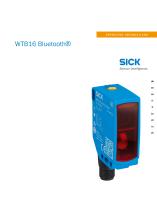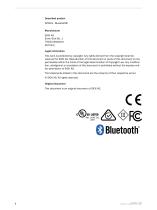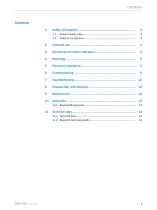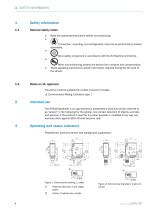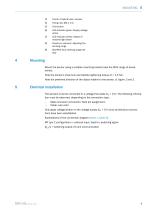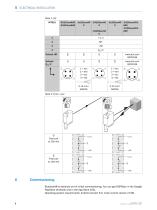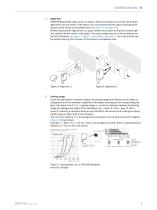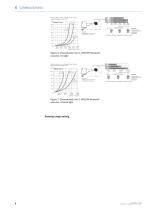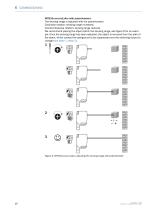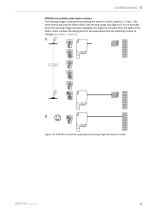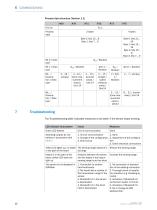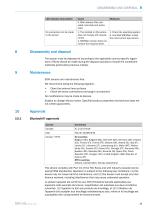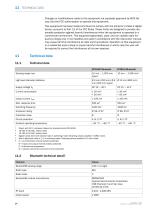Estratti del catalogo
OPERATING INSTRUCTIONS SICK Sensor Intelligence.
Aprire il catalogo a pagina 1OPERATING INSTRUCTIONS
Aprire il catalogo a pagina 2Described product WTB16 - Bluetooth® Manufacturer SICK AG Erwin-Sick-Str. 1 79183 Waldkirch Germany Legai information This work is protected by copyright. Any rights derived from the copyright shall be reserved for SICK AG. Reproduction of this document or parts of this document is only permissible within the limits of the legai determination of Copyright Law. Any modifica-tion, abridgment or translation of this document is prohibited without the express writ-ten permission of SICK AG. The trademarks stated in this document are the property of their respective owner. © SICK AG. All rights...
Aprire il catalogo a pagina 38022691 | SICK Subject to change without notice
Aprire il catalogo a pagina 4Safety information General safety notes Read the operating instructions before commissioning. Connection, mounting, and configuration may only be performed by trained specialists. ■ Not a safety component in accordance with the EU Machinery Directive. When commissioning, protect the device from moisture and contamination. These operating instructions contain information required during the life cycle of the sensor. Notes on UL approval The device must be supplied by a Class 2 source of supply. UL Environmental Rating: Enclosure type 1 Intended use The WTB16 Bluetooth is an opto-electronic...
Aprire il catalogo a pagina 5@ Center of optical axis, receiver © LED indicator green: Supply voltage active 7 LED indicator yellow: Status of received light beam © Press-turn element: Adjusting the sensing range ® BluePilot blue: Sensing range dis- Mount the sensor using a suitable mounting bracket (see the SICK range of acces-sories). Note the sensor's maximum permissible tightening torque of < 1,3 Nm. Note the preferred direction of the object relative to the sensor, cf. figure 1 and 2. Electrical instaNation The sensors must be connected in a voltage-free state (UV = 0 V). The following informa-tion...
Aprire il catalogo a pagina 6Table 2: Push / pulì 6 CommissioningBluetooth® is switched on for initial commissioning. You can get SOPASair in the Google PlayStore (Android) and in the App Store (iOS). Operating system requirements: Android version 6.0, most current version of iOS. Subject 8022691 | SICK to change without notice
Aprire il catalogo a pagina 7Alignment WTB16P Bluetooth®: Align sensor on object. Select the position so that the red emitted light beam hits the center of the object. You must ensure that the optical opening (front screen) of the sensor is completely clear [see figure 3, see figure 4]. WTB16I Bluetooth®: Align sensor on object. Select the position so that the infrared light (not visible) hits the center of the object. The correct alignment can only be detected via the LED indicators. see figure 3, figure 4 , see table 1, see table 2. You must ensure that the optical opening (front screen) of the sensor is completely...
Aprire il catalogo a pagina 8Example: Sensing range on black, 6%, A = Detection distance (depending on object remission) BluePilot; Sensing range indicator (blue LED) Teach-Turn adjustment A = Detection distance (depending on object remission) BluePilot; Sensing range indicator (blue LED) Teach-Turn adjustment Sensing range setting Subject 8022691 I SICK to change without notice
Aprire il catalogo a pagina 9COMMISSIONING 6 WTB16x-xxxxxx2xAxx with press-turn element: The sensing range is adjusted by pressing the teach-in button (approx. 1-3 sec.). Depending on the requirements, the potentiometer can be used for fine-tuning (without pressing the teach-in button). Clockwise rotation: sensing range increased. Counterclockwise rotation: sensing range reduced. The sensing range can also be adjusted using just the potentiometer. We recommend placing the object within the sensing range, see figure 8 for an example. Once the sens‐ ing range has been adjusted, the object is removed from the path of the...
Aprire il catalogo a pagina 106 COMMISSIONING WTB16x-xxxxxx1xAxx with potentiometer: The sensing range is adjusted with the potentiometer. Clockwise rotation: sensing range increased. Counterclockwise rotation: sensing range reduced. We recommend placing the object within the sensing range, see figure 9 for an exam‐ ple. Once the sensing range has been adjusted, the object is removed from the path of the beam, which causes the background to be suppressed and the switching output to change (see table 1, table 2). Figure 9: WTB16x-xxxxxx1xAxx, adjusting the sensing range with potentiometer 8022691 | SICK Subject to change...
Aprire il catalogo a pagina 11COMMISSIONING 6 WTB16x-xxxxxx3xAxx with teach-in button: The sensing range is adjusted by pressing the teach-in button (approx. 1-3 sec.). We recommend placing the object within the sensing range, see figure 10 for an example. Once the sensing range has been adjusted, the object is removed from the path of the beam, which causes the background to be suppressed and the switching output to change (see table 1, table 2). Figure 10: WTB16x-xxxxxx3xAxx, adjusting the sensing range with teach-in button 8022691 | SICK Subject to change without notice
Aprire il catalogo a pagina 12Process data structure (Version 1.1) 8022691 | SICK to change without notice
Aprire il catalogo a pagina 13This device complies with Part 15 of the FCC Rules and with Industry Canada licence-exempt RSS standard(s). Operation is subject to the following two conditions: (1) this device may not cause harmful interference, and (2) this device must accept any inter-ference received, including interference that may cause undesired operation. Le présent appareil est conforme aux CNR d'industrie Canada applicables aux appareils radio exempts de licence. L'exploitation est autorisée aux deux conditions suivantes: (1) l'appareil ne doit pas produire de brouillage, et (2) l'utilisateur de l'appareil doit...
Aprire il catalogo a pagina 14Changes or modifications made to this equipment not expressly approved by SICK AG may void the FCC authorization to operate this equipment. This equipment has been tested and found to comply with the limits for a Class A digitai device, pursuant to Part 15 of the FCC Rules. These limits are designed to provide rea-sonable protection against harmful interference when the equipment is operated in a commercial environment. This equipment generates, uses, and can radiate radio fre-quency energy and, if not installed and used in accordance with the instruction manual, may cause harmful...
Aprire il catalogo a pagina 15Tutti i cataloghi e le schede tecniche SICK
- W4F it
17 Pagine
- IMS it
13 Pagine
- SLG-2 it
14 Pagine
- T-Easic® FTS
4 Pagine
- midiCam
5 Pagine
- W4-3 PTFE
4 Pagine
- IO-Link Supplement
5 Pagine
- T-Easic FTS
56 Pagine
- T-Easic® FTS
12 Pagine
- FLOWSIC100 PROCESS
134 Pagine
- SPEETEC 1D
6 Pagine
- SPEETEC
2 Pagine
- Photoelectric laser sensors
20 Pagine
- SMART SENSORS
48 Pagine
- Photoelectric sensors_2019
20 Pagine
- AHS/AHM36 SSI Inox
29 Pagine
- STEEL INDUSTRY
8 Pagine
- MultiPulse
37 Pagine
- Safe Robotics Area Protection
32 Pagine
- ENCODERS AND INCLINATION SENSORS
40 Pagine
- EDS/EDM35
12 Pagine
- G2F Photoelectric sensors
20 Pagine
- TR110 Lock
20 Pagine
- 24-hour helpdesk
8 Pagine
- OPTO-ELECTRONIC PROTECTIVE DEVICES
32 Pagine
- outdoorScan3
20 Pagine
- EnforceKey Single Door
84 Pagine
- LD-LRS Laser Measurement System
6 Pagine
- PET Pressure transmitter
44 Pagine
- LFV 310/330
48 Pagine
- WT18X-3P930
2 Pagine
- T-Verteiler mit Taster
8 Pagine
- Proximity Sensors
20 Pagine
- Registration Sensors
24 Pagine
- FLG Standard automation light grids
12 Pagine
- Advanced Automation Light Grids
92 Pagine
- QAL3 Master
4 Pagine
- MCS100FT FTIR Analysis System
12 Pagine
- GM960 Boiler Wall Monitor
8 Pagine
- Dust measuring devices
171 Pagine
- Automation Light Grids
228 Pagine
- Maritime Emissions Monitoring
2 Pagine
- Raw Gas Measurement
2 Pagine
- TranspaTect product information
16 Pagine
- GR18 product information
56 Pagine
- Top Products from SICK
486 Pagine
- SICK Essentials
118 Pagine
- Magnetic Cylinder Sensors
164 Pagine
- Presence Detection
170 Pagine
- Industrial Safety Systems
1054 Pagine
- Fluid Sensors
174 Pagine
- Encoders
388 Pagine
- Distance Sensors
404 Pagine
- Detection and Ranging Solutions
124 Pagine
- Identification Solutions
308 Pagine
- Zone control
5 Pagine
- fiber-optic sensors
5 Pagine
- PACKAGING2009/10
20 Pagine
- Inductive proximity sensors
5 Pagine
Cataloghi archiviati
- Photoelectric sensors_2012
5 Pagine
- safety laser scanners
5 Pagine
- 3D cameras
6 Pagine
- Miniature photoelectric sensors
5 Pagine
- MCS300P Superior in front
4 Pagine
- MKAS Compact Analysis system
2 Pagine
- FLOWSIC 600
4 Pagine
- GM32 In-situ gas analyzer
8 Pagine
- W9-2 Small photoelectric sensors
7 Pagine
- Product overview Industrial Sensors
100 Pagine
- News Factory Automation
8 Pagine
- Encoder
- Modulo di misura
- Analizzatore di gas
- Encoder rotativo
- Analizzatore di concentrazione
- Analizzatore di monitoraggio
- I/O digitale
- Sistema di misurazione
- Modulo I/O
- Encoder incrementale
- Pulsante
- Sensore di prossimità
- Analizzatore automatico
- Analizzatore benchtop
- Encoder rotativo incrementale
- Modulo I/O digitale
- Interruttore tecnologia
- Encoder rotativo assoluto
- Sensore di prossimità cilindrico
- Analizzatore di processo




